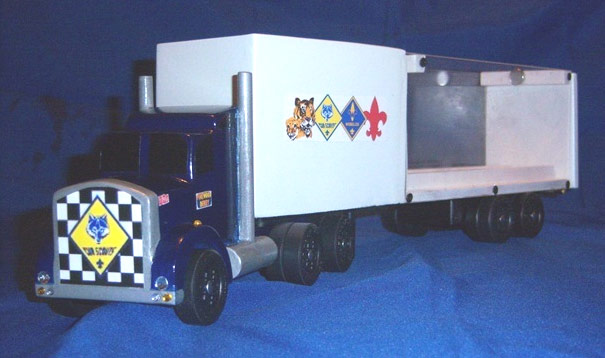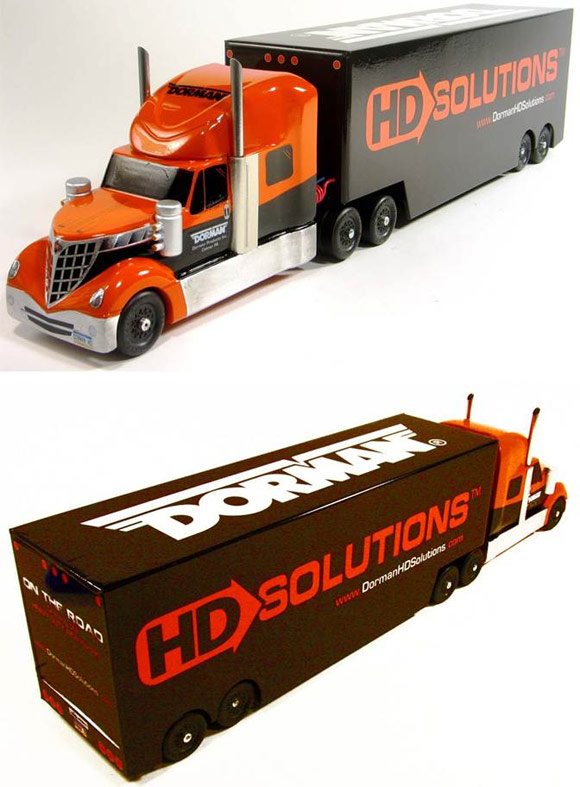– Feature Article – Slicker is Better
– Pinewood Derby Car Showcase
– Q&A
Slicker is Better
By Randy Davis
(An update of an article originally published February 6, 2002)
Everyone would agree that lubrication is one of the keys to creating a competitive pinewood derby car. But once the discussion moves into types of lubricants, lubricating methods, etc., agreement begins to vanish. Why? Because there is no one perfect lubricant or one sure- fire way to lubricate.
So, the following information is based on my experience and preference, and I will attempt to explain the reason behind each step. Afterward, the decision is yours as to what to do with the information.
Types Of Lubricants
Michael Lastufka discussed the physical nature and properties of the top lubricants in a previous article (Volume 1, Issue 7 – The Elusive Best Lubricant). But in summary, there are two basic types of lubricants: dry and liquid. This article will focus on the dry category, which contains several choices: graphite, molybdenum disulfide (MS2), tungsten disulfide (TS2), teflon (Dry White), and boron nitride.1 In experimenting with these materials, my observation is that graphite is the superior choice. However, the information in this article will apply to any dry lubricant. For simplicity, I will use the word “lube” from here forward. To me “lube” refers to graphite; to you “lube” can refer to your favorite (or required) dry lubricant.
Cautions
Before getting into the basics of lubricating I would like to offer a few precautions:
- Safety – The use of dry lubes can result in a considerable number of particles floating in the air. So when lubricating with a dry lube, wear a particle mask.
- Cleanliness – Dry lubes can be quite messy. First, apply the lube outside, or in a garage or workshop. Next, always put some old newspaper on the work surface while lubricating. When done, roll up the newspaper and throw it away.
Axle And Wheel Bore
Most of the friction that affects the pinewood derby car occurs between the axle and wheel bore. So when lubricating, spend extra time focusing on this key area.
The lube will not stick to the axle2, but instead sticks to the wheel plastic. So, to thoroughly lubricate, a lube coating must be built up on the wheel bore. Listed below is my procedure for building up this lube coating. Do this procedure BEFORE the wheels and axles are mounted on the car.
- Fill the bore of the wheel with graphite.
- Insert an axle into the wheel bore.
- With one hand, firmly grasp the axle and hold the axle horizontal to the ground.
- With the other hand, spin the tire gently — don’t drop the axle. Spin the wheel ten times.
- Hold the axle with the wheel hanging towards the ground.
- Deposit some lube into the gap between the axle and wheel bore.
- Tap the wheel gently to help move the lube down into the wheel bore.
- Repeat steps 3 to 7, two more times.
- Finally, spin the wheel 10 times. Don’t add any more graphite after this point.
After performing this procedure the first time, keep the wheel/axle pairs together as a unit.
At some point in this procedure you should observe the wheel beginning to spin much more freely and with less vibration. At this point, the axle is no longer rubbing on the plastic of the bore, but is instead rubbing on the graphite coating. Make sure to continue the procedure after this point, as you want to ensure a complete coating on the wheel bore.
Inner And Outer Wheel Hubs
The inner wheel hub will contact the side of the car, while the outer side of the wheel hub will contact the axle head. The previous step should have lubricated these areas. But to be sure, dip your index finger into the lube and rub it onto the inner wheel hub. Then apply lube onto the outer hub and then rub the axle head against the outer hub to work it in.
Inner Edge Of The Wheels
As the car is rolling down the track it will bump the guide rail one or more times. So the inner edge of the wheel should be lubricated. To lubricate, dip your index finger in the lube, and rub the lube onto the inner edge. I recommend performing this step three times.
Wheel Tread
Per “Graphite on the Tread” in Volume 8, Issue 2, there is possibly a very slight benefit to lubricating the tread surface. The lube can be applied with an index finger, or with lube on a rag. In either case, rub the lube in thoroughly, then wipe off any excess lube.
Car Body
The inner side of the wheel hub will contact the side of the car. So, dip your index finger into the lube and rub it on the side of the car where the hub will contact the body.
Some people avoid painting this area, and then rub lube into the bare wood. In my experience, a good paint job and clear coat finish results in a hard slick surface for the hub to rub against. If the inner hub is lubed thoroughly, then graphite on the car body is not needed.
Clean-Up
Before mounting the wheels and axles on the car, wipe off the excess lube. Loose lube on the exterior surfaces of the car doesn’t really help speed, but it does make a mess on the track, staging area, carpet, etc.
Conclusion
Thorough lubrication is vital to the performance of a pinewood derby car. So take the time to follow these steps. Don’t be like the folks that came to our race a few years back without using any lubricant. The child watched sadly as the car stopped short of the finish line.
1For more information on lube types, check out these articles:
Lubricant Testing – Volume 8, Issue 10
Liquid Lube Testing – Volume 9, Issue 4
2Lube can be attached to an axle if the lube is mixed with a binder (alcohol or similar). But, in the case of graphite, this changes the molecular bonding of the graphite resulting in a composition that is not as effective as powdered lube.
Car Showcase
18 Wheeler – Scott Carpenter
I built this truck for our pack. Its trailer acts as or “Go/No-go” inspection box too. I have entered it in the Dremel derby design contest and am hoping it does well.
HD Solutions – Andy Holzer
I built this pinewood derby truck for Dorman Products for competition between companies. The truck has bearings on 10 of the axles (the ones that are touching the track).
Q&A
If we need to add some weight to the front of the car to get it to balance at 7/8 to 1 inch will it slow the car down?
If your track is nice and smooth, then you can probably run with a 7/8 inch balance point. If you are concerned that the track is a little rough, then you can add weight forward on the car to move the balance point forward. This will reduce the potential speed a little, but will increase stability. This is always a trade-off in pinewood derby racing.
I have read differing opinions about the use of tapered axle heads when using the newer BSA wheels. Assuming there can be no modifications to the hubs, do you have an opinion about whether a tapered or flat axle head is better? Thanks.
Good question. I see three possibilities:
- Subtle Taper – contact only on the outer ring of the wheel – tapered head better than flat head (less contact).
- Medium Taper – contact on both inner and outer ring – flat head better.
- Large Taper – contact only on the inner ring of he wheel – tapered head better than flat head (contact closer to shaft) – This configuration may be very obvious as the diameter of the head would be reduced.
Our products 4094, 4095, 4096, 4097, 4098 and 4099 have a subtle taper.
Want Answers?
Do you have a pinewood derby-related question? If so, e-mail us your question.We answer all questions by e-mail, but not every question will appear in the Q&A section of the newsletter.
Back Issues
Are you a new subscriber, or have you missed some of the previous newsletters? Don’t miss out; all of the issues for Volume 5 through Volume 17 are posted on our web site.
Newsletter Contributions
We welcome your contributions. If you would like to contribute an article, a web site review, a speed tip, or a pinewood derby memory, please e-mail us.
Subscription Information
The Pinewood Derby Times is a free e-newsletter focused on pinewood derby racing. It is published biweekly from October through March.
If you haven’t already done so, please forward this issue to your pinewood derby friends. But please don’t subscribe your friends. Let them decide for themselves. Thanks.
If this newsletter was forwarded to you, why not subscribe to receive this newsletter. There is no cost, and your e-mail address is safe, as we never sell or share our distribution list.
To subscribe, send a blank e-mail to
[email protected]
You will receive a confirmation e-mail. Reply to the confirmation e-mail and you will start receiving the Pinewood Derby Times with the next issue.
Randy Davis, Editor, Pinewood Derby Times
E-Mail: [email protected]
(C)2018, Maximum Velocity, Inc. All rights reserved. Please do not reprint or place this newsletter on your web site without explicit permission. However, if you like this newsletter we grant permission, and encourage you to e-mail it to a friend.
Maximum Velocity disclaims any personal loss or liability caused by utilization of any information presented in this newsletter.
The Pinewood Derby Times is not specific to, and is not affiliated with the Boy Scouts of America, YMCA, Awana, or any other organization.
(R)Maximum Velocity is a registered trademark of Maximum Velocity, Inc.
(R)Pinewood Derby is a registered trademarks of the Boys Scouts of America.
(R)Awana is a registered trademark of Awana Clubs International.
All other names are trademarks of their respective owners.


